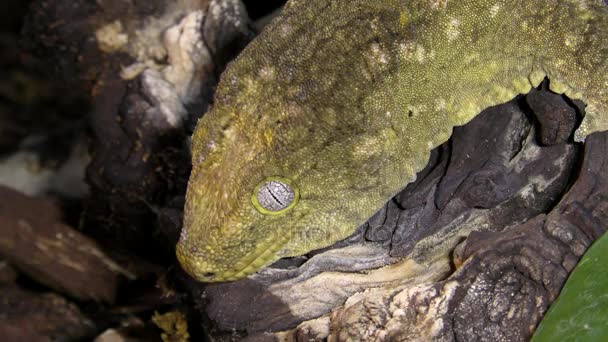ANIMAL: New Caledonian Giant Gecko Rhacodactylus leachianus Type of Animal: Gecko Habitat: Coastal forest, closed humid forest, montane forest Location(s): S & E New Caledonia & smaller surrounding islands Appearance: Largest gecko in world, base color comes in shades of mottled green, gray, & brown, heavy body, loose skin, large yellowish head, small stumpy tail, covered in blotches ranging from vivid white to black speckled white to pink to purple, bulbous eyes, cylindrical Food/Diet: Fruit, insects, insect larvae, caterpillars, worms, mice, flowers, smaller lizards (including smaller members of own species), spiders, nectar, sap, tree snails, nestling birds, bats, tree frogs Status in Wild: Stable Conservation: Breeding from zoos, wildlife parks, breeders, & aquariums Lifestyle: Adults found in male-female pairs or alone. Juveniles solitary. Additional Info: Called: Male Female Young-Hatchling Group-Pair Weight: 7.47-9.84 oz Gestation: 3-4.5 months Life Span: 15-20 years Body Length: Adult-1.16-1.41 ft Young-4 in Tail Length: 3 in Main predators are introduced rats, introduced cats, & little fire ants (introduced). Pairs extremely territorial & will fight intruders to death. Younger individuals highly skittish. Sexually mature at 3-5 years. They can be defensive at times & have very strong jaws. This species also known as Leach’s Giant Gecko & Leachie Gecko. First described by French naturalist/zoologist Georges Cuvier in 1829. They’re nocturnal & arboreal. Females lay 2 eggs at a time, having up to 10 clutches per year. She’ll often glue them to tree. Colors great for camouflage. They rarely descend to the ground. Potential threats are over-collection, deforestation/logging, habitat loss, introduced predators, habitat degradation from introduced ungulates (deer & pigs), & electrocution from power lines. Fun Fact(s): Have special pads on feet to climb steep slippery surfaces. Due to demand for pets, private breeders breeding them, reducing need to collect from wild. They can be quite vocal, growling, grunting, barking, cooing, whistling, clucking, & squeaking. Under certain conditions, can detach tails if threatened, startled, or grasped. Can become tame w/ frequent handling. Since they make loud growls, locals call them “tree devils.”
